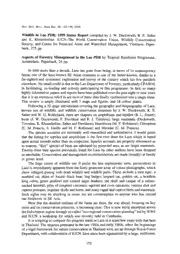
Wildlife in Lao PDR: 1999 Status Report. by J.W. Duckworth, R.E. Salter & K. Khounboline PDF
Preview Wildlife in Lao PDR: 1999 Status Report. by J.W. Duckworth, R.E. Salter & K. Khounboline
NAT. HIST. BULL. SIAM Soc. 48: 155-156,2 000 Wildlife in Lao PDR: 1999 Status Report compiled by J. W. Duckworth,R . E. Salter and K. Khounboline. IUCN-The World Conservation Union,W i!dlife Conservation Society,a nd Centre for Protected Areas and Watershed Management,V ientiane. Paper- back,2 75 pp. Aspects of Forestry Management in the Lao PDR by Tropical Rainforest Programrne, Amsterdam. Paperback,2 4 pp. In little more than ad ecade,L aos has gone from being,in terms of its contemporary fauna,o ne of the least-known SE Asian countries to one of the better-known,th anks to a far-sighted and systematic exploration and survey of the country which has few parallels elsewhere. Nos mall credit is due to the Lao Department of Forestry,pa rticularly CPAW M, in facilitating,c o-Ieading and actively participating in this programme. In fact,s o many highly inforrnative papers and reports have been published over the past eight or nine years that it is an enorrnous relief to see most of these data finally synthesized into as ingle tome. This review is amply illustrated with 7m aps and figures,a nd 18 colour plates. Following a3 2-page introduction covering the geography and biogeography of Laos, human use of wildlife,a nd wi!dlife conservation measures by J. W. Duckworth,R . E. Salter and W. G. Robichaud,th ere echapters on amphibians and repti!es (B. L. Stu制); 紅 birds (J. W. Duckworth,P. Davidson and R. J. Timmins); large mamrnals (Duckworth, Timrnins,K. Khounboline,Sa lter and Davidson); Insectivora (M. F. Robinson); Chiroptera (c. M. Francis,A . Guilln and M. F. Robinson) and Muridae (C. M. Francis). The species accounts are extremely well researched and authoritative. 1w ould guess that the listing for reptiles and amphibians is the first ever done for Laos which is based upon actual records rather than on conjecture. Species accounts are properly referenced as to sources.“Key" species of birds are tabulated by protected area,as are larger mammals. Twenty-three bird species previously listed for Laos by other authors have been dropped as unreliable. Conservation and management recomrnendations are made (usually) at family or genus level. The huge extent of wildlife use (1 prefer the less euphemistic term,p ersecution) in Laos is immediately apparent from the fairly gruesome rayof colour photographs,w hich 紅 show villagers posing with dead wildlife and wildlife parts. These include as hot tiger,a marbl巴dcat,s kins of Asiatic black bear,h og badger,l eopard cat,g olden cat,a h eadless king cobra,g reen peafowl and crested argus feathers; the skull and casque of ar ufous- necked hombill; piles of songbird carcasses; squirrel and civet carcasses; various shot and captive primates,un gulate skulls and horns,an d many caged and captive birds and mamrnals. Such sights may be shocking to some,b ut are commonplace to anyone who has carried out fieldwork in SE Asia. Now that the detai!ed outlines of the fauna are there,th e way ahead,fo cusing on key areas and on conservation priorities,is becoming clear. This is now being attempted across the Indochinese region through so-called “eco-regional conservation planning" led by WWF and IUCN,a w orkshop for which was recently held in Cambodia. It is tempting to compare the progress made in Laos in as cant few years with that here in Thailand. The impetus generated in the late 1950s and early 1960s,w hen the beginnings of al egal framework for nature conservation in Thailand were set up through Royal Forest Department,wi th collaboration of IUCN,ha ve since been squandered by al arge,in efficient, 155 156 REVIEWS and largely uninterested govemment bureaucracy. Thailand has over 100 national parks, 30pluswi1dlife sanctuaries,m any nohuntingareas and other smaller reserves. Yet there ・ ・ has never been ap rogram of systematic survey of these areas. There has sc lybeen any 紅白 attempt to assess the contributions of these areas to biodiversity conservation; nor to identify where the loopholes lie. After nearly forty years of involvement in conservation in Thailand,no t only does RFD lack the knowledge and capability to produce ar eview of sirnilar scope or of ac omparable level of scholarship to that which now exists for Laos, it is doubtful whether any senior RFD official would even concede the need for one! Will the groundwork laid down by Laos in the past decade be sirnilarly squandered? The signs are not good. Many of出ekey figures so important in the early days of CPAW M have been sidelined. The initial interest in environmental conservation shown by the Lao govemment appesto have faded and been replaced by am ore heavi1yd evelopment- 紅 oriented approach. Presumably the oligarchy has calculated that it can best hope to maintain its power and rni凶rnisesocial u町est由roughthe trickle down of funds from mega-pr吋,ects- roads,d ams and other construction projects; conventional expo此・orientedagricultural development,a nd the like. Shortly after Wildl砕 InLaoP DR arrived on myd esk,1 r eceived the euphernistically titled Aspects 01 Forestry Management初匂oPDR. This is as ca仕ungindictment of logging policy in Laos,wh ich is effectively dictated by the prime rninister' so ffice and the rnilitary,wh ich set the log quotas and determine which areas are to be logged. TheD ivision of Inventory and PI佃 ningof the Department of Fores位yin Laos is completely m釘'ginalised in this process: there is scarcely even ap retence at sustainability. The massive investment in timber processing capacity over the past few yesleads to the inescapable conclusion 紅 伽 tit is Laos' system of National Biodiversity Conservation Areas which will shortly go under the axe and the chainsaw. Phil伊, Round Center for Conservation Biology Faculty of Science Mahidol University Rama 6R oad Bangkok 10400
